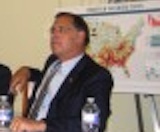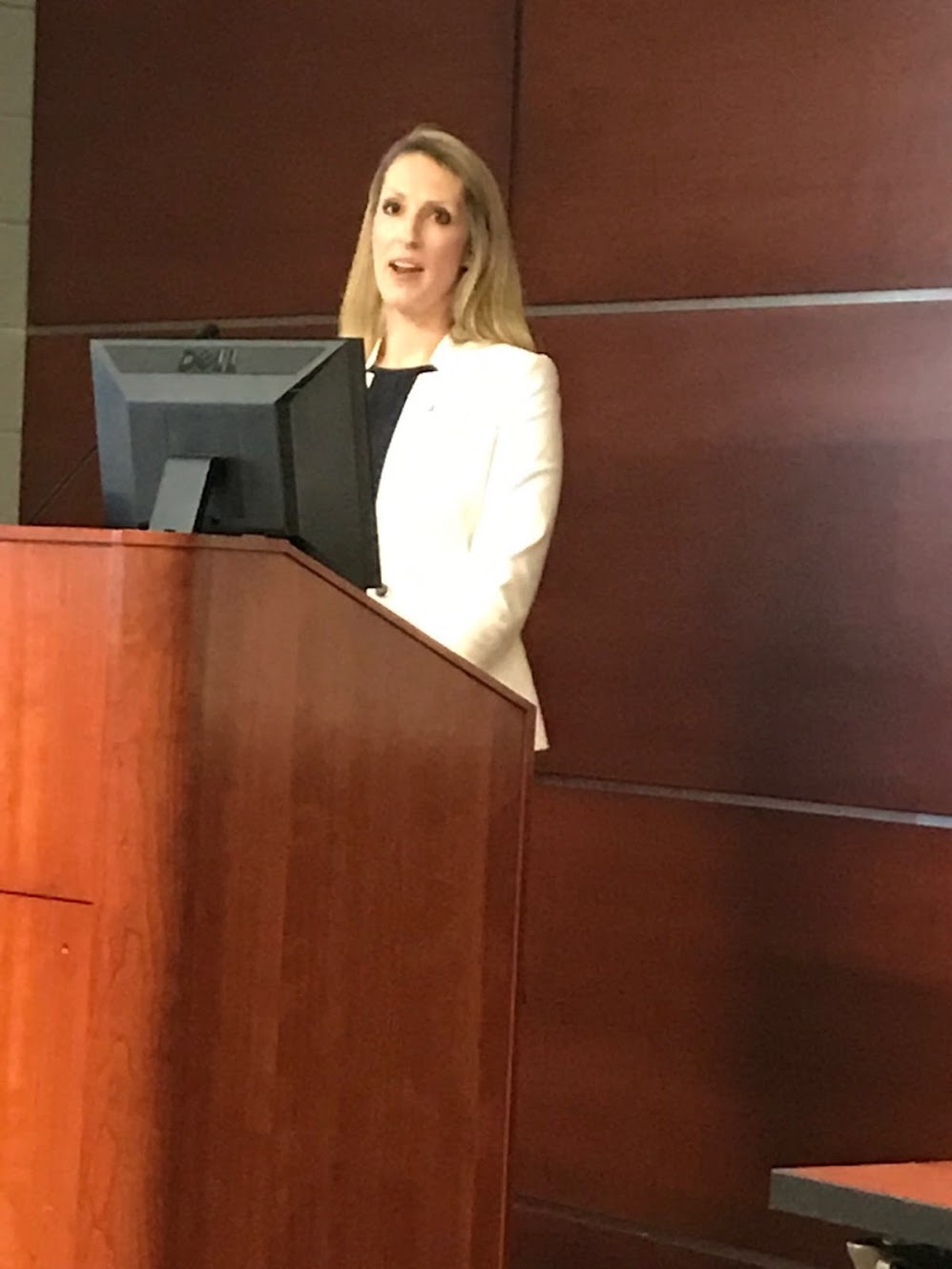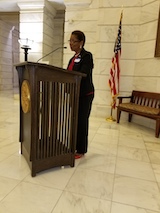Economic Equality Caucus
which advocates for economic equality across the USA.
| Home | Organizational Structure | State Coordinators | Executive Director | Caucus Articles | Memberships | |||||
| "Delta Vision, Delta Voices" | ||||||||||
|
Help Advocate for Economic Progress and Equality. Donate to the Delta Caucus/Economic Equality Caucus. |
||||||||||
Delta Grassroots Caucus Events

Credit Michael Hibblen/ KUAR News, Arkansas Public Radio; Former President Bill Clinton speaking to the Delta Grassroots Caucus on May 2, 2013, at the University of Arkansas Clinton School of Public Service, Little Rock

U. S. Senator John Boozman, Arkansas, at a Delta Grassroots Caucus meeting at the US Capitol

Brad Cole, Executive Director of the Municipal League of Illinois; previously a senior aide to former Republican US Sen. Mark Kirk of Illinois, earlier Mayor of Carbondale, Illinois, veteran Delta regional advocate, speaking at the Delta regional conference in West Memphis, Arkansas on April 26, 2019.

President Bill Clinton makes a comment to Delta Caucus Director Lee Powell at a meeting in Blytheville, Arkansas (in the northeast Arkansas Delta) on Nov. 2, 2014

The Delta Caucus would like to pay tribute to the late, great U.S. Sen. Thad Cochran of Mississippi, a powerful force in the US Senate for decades and a champion for the Delta. Sen. Cochran passed away on May 30, 2019. He spoke to the Delta Caucus on many occasions over the years (he is pictured above speaking to a Caucus event on Capitol Hill in Washington, DC) and his thoughtful, courteous and bipartisan leadership will be sorely missed.

Marcie Lawson, Executive Director, Sikeston, Missouri Regional Chamber and Area Economic Development Corporation, speaking at the Delta regional conference in West Memphis, Arkansas on April 26, 2019.

Alan Gumbel, Greater Memphis Alliance for a Competitive Workforce, Memphis, Tennessee, speaking at the Delta regional conference in West Memphis, Arkansas on April 26, 2019.

Mayor Shirley Washington of Pine Bluff, AR, speaking to the Delta Caucus at the Arkansas Capitol Rotunda in 2017.
Hunger in the Delta Rising Sharply, according to Hunger Free America Report--Message of Nov. 28, 2022
Posted on November 28, 2022 at 04:38 PM
Mississippi Delta Grassroots Caucus Nov. 28, 2022 CONTACT: Lee Powell, Caucus Director (202) 360-6347
Hunger Free America Report Shows Hunger Rising Sharply in Delta Region and Nationally
The Delta Caucus conveys this report by Hunger Free America and the Kupersmit professional research organization showing hunger was sharply higher in the Delta especially and also in other regions of the country in October of 2022 than in October of 2021.
The surge was caused by the expiration of Child Tax Credits and universal school meals, combined with the impact of inflation. Please contact your Members of Congress and urge them to reinstate these vital programs and increase the SNAP (formerly food stamps) benefits.
The report found that the number of people without enough food over one 7-day period was 29.6% higher in October 2022 than October 2021. The increase in Mississippi was a massive 60%, in Arkansas a high increase of 24%.
See Hunger Free America website– hungerfreeamerica.org for the full report
OVERALL FOOD INSECURITY
The Delta states unfortunately continued to fare poorly: three of the highest food insecurity rates in America were in our region for the period between 2019-2021, according to USDA data. (Texas had the highest rate at 16.8% and Oklahoma the third highest at 15.3%)
• Mississippi second highest nationally at 15.6%
• Louisiana fourth at 14.8%,
• Arkansas fifth at 14.3%.
• Kentucky’s level was 13%
• Alabama: 12.8%
• Tennessee: 11.4%
CHILD FOOD INSECURITY:
• Mississippi was the second worst nationally at 19%,
• Louisiana was the fourth worst at 18.2%.
• Kentucky: 17.0%
• Arkansas: 16.8%
• Alabama: 16,4%
• Tennessee: 13.3%
OLDER PEOPLE (60 years or older):
• Mississippi had the highest food insecurity nationally for older people at 12.6%.
• Louisiana was next at 12.3%
• Kentucky: 8.8%
• Alabama: 8.8%
• Arkansas: 7.6%
• Tennessee: 6.9%
EMPLOYED ADULTS
This is a problem for many people who are employed, not just the unemployed:
• Arkansas had the highest food insecurity rate for employed adults at 11.9%
• Louisiana was fourth at 11.2%.
• Mississippi: 11.0%
• Tennessee: 8.9%
• Alabama: 8.6%
• Kentucky: 7.0%
This surge reversed the impressive gains made in the previous year
The number of households without enough to eat nation-wide declined 41.1% between December 2020 and April 2021, coinciding with a 22.7% increase in federal SNAP spending during the same time period, according to U.S. Census Household Pulse data analyzed by the report.
Food insufficiency rates today, however, are back to what they were in April 2020, when the US was still in the early stages of the pandemic.
Note on the condensed and selected data from the report:
We include data here for the heartland Delta states of Arkansas, Louisiana, Mississippi, Tennessee, and the Alabama Black Belt, which is geographically not adjacent to the Delta but broadly similarly demographically and historically. Ideally it would of course be much better to include only data for the Delta counties, but unfortunately statistics are kept at the state-wide, county and municipal levels, but generally not at the regional level for the Greater Delta. We have included data for those states where the state-wide data is at least generally indicative of the Delta situation.
It would be inaccurate to include state-wide data for Illinois and Missouri. Southeast Missouri and southern Illinois are integral parts of the region and have characteristically high levels of economic distress in general, but they are relatively small parts of their states and the rest of those two states have areas that are relatively much more urban and prosperous. It would not convey the reality in southeast Missouri and southern Illinois to convey state-wide data. In the other states the differences between the Delta areas and the rest of the states’ areas is much smaller.
Tennessee does have some prosperous areas outside of the Delta such as the Nashville area, but the large Appalachian area of east Tennessee is broadly similar to the Delta in its relatively high level of economic distress.
We use the broad definition of the Greater Arkansas Delta to include Little Rock and basically the eastern half of the state. Northwest Arkansas (which of course is not in the Delta) is much more prosperous than eastern Arkansas, but the Delta is a large part of the state as a whole. The Jonesboro-Paragould area in northeast Arkansas is much more prosperous than most of east Arkansas. West Little Rock is mostly more prosperous, but there are pockets of substantial poverty in some Little Rock neighborhoods.
Executive Summary of Hunger Free America Report
(SEE EXTENDED CONTENT)
EXECUTIVE SUMMARY OF HUNGER FREE AMERICA REPORT
• The number of Americans without enough food over one 7-day period was 29.6% higher in October of 2022 than in October of 2021. Hunger Free America attributes that surge to the expiration of the expanded Child Tax Credits and universal school meals, coupled with the impact of inflation.
• Nearly three-fourths (73.3%) of food pantries and soup kitchens that responded to a nationwide survey by Hunger Free America said they served more people in 2022 than in 2021.
• The number of households without enough to eat in the United States dropped by 41.1% between December 2020 and April 2021, coinciding with a 22.7% increase in federal SNAP spending during the same time period, according to U.S. Census Household Pulse data analyzed by the report. Food insufficiency rates today, however, are back to what they were in April 2020, when the US was still in the early stages of the COVID-19 pandemic. 4 Other findings of the study:
• Nationally, 11.0% of Americans were found to live in food insecure households between 2019 and 2021. According to USDA data, the states with the highest rates of food insecure individuals from 2019-2021 were Texas (16.8%), Mississippi (15.6%), Oklahoma (15.3%), Louisiana (14.8%), and Arkansas (14.3%).
• 14.5% of children in the U.S. lived in food insecure households in the 2019-2021 time period. The states with the highest rates of food insecure children were Delaware (20.2%), Mississippi (19.0%), Oklahoma (18.9%), Michigan (18.6%), and Louisiana (18.2%).
• Nationally, 8.2% of employed adults in the U.S. lived in food insecure households during the three-year time period. The states with the highest rates of food insecurity among employed adults were Arkansas (11.9%), Delaware (11.4%), Texas (11.3%), Louisiana (11.2%), and Oklahoma (11.2%).
• In the U.S., 7.0% of older Americans, defined as people 60 years and older, lived in food insecure households (table 4). Mississippi had the highest rate of food insecurity among older Americans at 12.6%, followed by Louisiana (12.3%), District of Columbia (11.5%), Oklahoma (9.6%), and South Carolina (9.6%).
• The states with the lowest rates of food insecurity were New Hampshire (5.3%), Minnesota (7.4%), Virginia (7.4%), Iowa (8.0%), and Rhode Island (8.0%).
A Message from Hunger Free America CEO Joel Berg, CEO of Hunger Free America
In the 21 years I’ve been writing introductions for our annual reports on hunger nationwide, in New York City, and New York State, two themes have emerged over and over – and over – again:
The richest nation, state, and city in the history of the world all have appallingly high numbers of residents who can’t afford enough food, even when the overall economy is theoretically strong; and
Public policies matter. When our government leaders take serious steps to reduce hunger and poverty, they decrease. When our government reverses those policies, hunger rises.
During the height of the pandemic, the U.S. economy essentially shut down almost overnight. School meals programs, which before the pandemic served 29 million lunches and 15 million school breakfasts, shuttered. Senior meals programs and some feeding charities, including those distributing government commodities, closed their doors. U.S. hunger soared.
The one reason we avoided mass starvation – and began to bring U.S. hunger rates down – was that the majorities in Congress, and later the Biden Administration, dramatically expanded the cash and food safety net for tens of millions of struggling Americans. SNAP – formerly called the Food Stamps Program – was greatly expanded, as was the WIC program for pregnant women and children under five. Schools were given the flexibility to serve meals (to be eaten at school or taken home) for children in families of all incomes.
The Pandemic EBT program was created to place food credits on electronic shopping cards for parents of children in closed public schools.
There is no question that these programs worked, both in reducing hunger and in improving nutrition. As a lead up to the historic September 28, 2022 White House Conference on Hunger, Nutrition, and Health (for which Hunger Free America was a key planner and participant), we released the results of a groundbreaking survey and a report demonstrating how increased federal food and cash aid during the pandemic served as a life preserver for low-income families nationwide.
The survey, which was conducted by Kupersmit Research on behalf of Hunger Free America and included responses from 800 households nationwide with at least one child and annual incomes below $40,000, found that recent increases in both Child Tax Credit payments and SNAP benefits relieved the economic and emotional burdens for those who received them, helping them afford more sufficient and more nutritious foods. It also enabled them to pay for other key expenses, like childcare and housing.
The survey also found that, overwhelmingly, low-income parents believe the best approach 6 to helping low-income people eat more healthily is increasing SNAP benefits overall, which they prefer far more than reducing food choices in SNAP. The report, “The Life Changing Power of Increased Food and Cash Aid”, researched and written by two postdoctoral fellows associated with the American Council of Learned Societies (ACLS), confirms that larger assistance had an overall highly positive impact on family well-being during the pandemic; that people were concerned about their health and knew about the importance of healthy foods; that the aid boost gave families the ability to afford more food for more weeks out of the month; and that there is still enduring social stigma associated with receiving government aid. The report was based on interviews with 60 program participants in 12 states.
As this report documents, the federally funded increases in food and cash assistance were far greater than the increases in food prices, leaving the vast majority of Americans in far better condition than they would have been without this extra aid. Despite the success of these increases, many of them, mostly due to opposition from conservatives in Congress, have either gone away entirely or are being ramped down, even as prices for food, rent, healthcare, fuel, etc. continue to soar. It’s no wonder that, as this report demonstrates, hunger and food insecurity rates continue to soar in all fifty states, especially among working people, children, and seniors. The solutions to these problems remain the same: businesses should voluntarily pay their workers a living wage, and when they don’t, the government should force them to do so. The government should also ensure a robust cash and food safety net when wages aren’t enough.
Congress should also pass the HOPE Act of 2021 (H.R.2336/S.1181), an innovative and ground-breaking bill – conceptualized and championed by Hunger Free America – which would dramatically modernize the delivery of social services and reinvent poverty policy in America by enabling low-income people to better access multiple benefits online and save money to buy their own home, start a small business, pay for college or job training, or develop a retirement account. The single best way to end hunger is to give more Americans the ability to develop assets to climb into – and stay in – the middle class. We know what steps are needed to end hunger in the U.S., and in doing so, lift us all. That’s why Hunger Free America is helping lead the movement to pressure officials to take the steps necessary to make that happen. With your help, we can make a hunger-free America a reality.
Back to the top